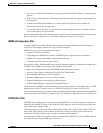
35-6
Catalyst 2960 and 2960-S Switch Software Configuration Guide
OL-8603-09
Chapter 35 Configuring IPv6 Host Functions
Configuring IPv6
Basic network connectivity (ping) must exist between the client and the server hosts before HTTP
connections can be made.
For more information, see the “Managing Cisco IOS Applications over IPv6” chapter in the Cisco IOS
IPv6 Configuration Library on Cisco.com.
IPv6 and Switch Stacks
The switch supports IPv6 forwarding across the stack and IPv6 host functionality on the stack master.
The stack master runs IPv6 host functionality and IPv6 applications.
While the new stack master is being elected and is resetting, the switch stack does not forward IPv6
packets. The stack MAC address changes, which also changes the IPv6 address. When you specify the
stack IPv6 address with an extended unique identifier (EUI) by using the ipv6 address ipv6-prefix/prefix
length eui-64 interface configuration command, the address is based on the interface MAC address. See
the “Configuring IPv6 Addressing and Enabling IPv6 Host” section on page 35-7.
If you configure the persistent MAC address feature on the stack and the stack master changes, the stack
MAC address does not change for approximately 4 minutes. For more information, see the “Enabling
Persistent MAC Address” section on page 7-17 in Chapter 7, “Managing Switch Stacks.”
Configuring IPv6
These sections contain this IPv6 forwarding configuration information:
• Default IPv6 Configuration, page 35-6
• Configuring IPv6 Addressing and Enabling IPv6 Host, page 35-7
• Configuring IPv6 ICMP Rate Limiting, page 35-9
• Configuring Static Routes for IPv6, page 35-10
Default IPv6 Configuration
Table 35-1 shows the default IPv6 configuration.
Table 35-1 Default IPv6 Configuration
Feature Default Setting
SDM template Default
IPv6 addresses None configured.


















